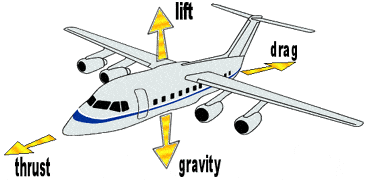There Are Four Forces of Flight

Let’s wrap this up on a scientific note. While flight may seem like magic, it is in fact governed by a number of forces that interact in various ways to allow us to travel through the skies. With a little bit of reading, it’s pretty easy to get a grasp on them and understand the basics of how giant metal objects can soar with such impunity. In essence the forces behind flight break down like this:
Lift is the force moving perpendicular to the direction of travel, generally generated by the movement of air over the wing. As the name suggests, it pushes the aircraft up, up and away.
Drag is a result of the aircraft moving through the air. As the air resistance works against the object’s motion, it can force it to slow down if there’s not another force acting against it . . .
Thrust is that other force: whatever energy is pushing the aircraft forward in its direction of travel and working to overcome the other forces that try to slow it or hold it still. Thrust moves air over the wing, thus creating lift.
Weight is the force of gravity working on the aircraft and trying to hold it still until there’s enough thrust to overcome both it and drag. We all know how gravity works; just go find an apple tree and wait to get hit on the head if you need a refresher.
